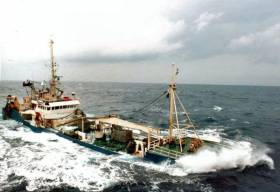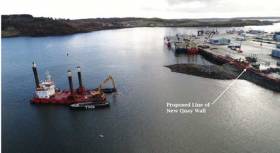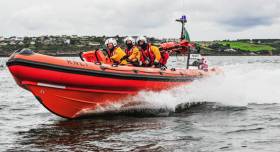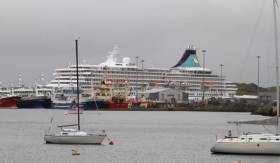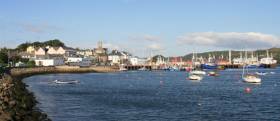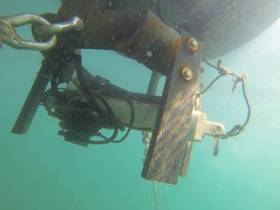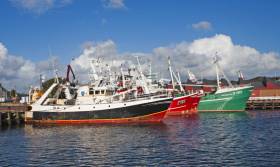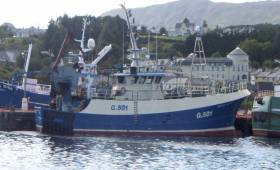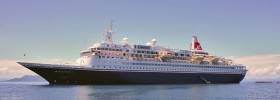Displaying items by tag: Killybegs
Irish State On Watch to Protect Sea Borders Amid Brexit Fears for Fishing
Both the Irish Naval Service and Air Corps, reports The Irish Times, are being primed to protect Irish sea fishing areas and vessels in a no-deal Brexit amid industry fears of tensions between EU and non-EU trawlers.
The UK crashing out of the EU without a deal would shut off British fishing waters to Irish trawlers and deprive the domestic fleet of access to lucrative fishing grounds that account for a third of the Irish catch.
The exclusion of fishing fleets from other EU member states from British waters would in turn increase the number of French, Spanish and Belgian trawlers in Irish fishing waters.
Sean O’Donoghue, chief executive of the Killybegs Fishermen’s Organisation, one of the country’s biggest fishing industry groups, warned that there would be “flashpoints” in the Irish Sea and waters off the north-west and south-west Irish coasts if no arrangements are put in place in the event of a no-deal Brexit.
The newspaper has more here on the story.
As part of Project Ireland 2040, The Minister for Agriculture, Food and the Marine, Michael Creed TD, announced the signing of a €14.7 million capital works contract to deliver a 120m long quay development and associated works at Smooth Point, Killybegs Fishery Harbour Centre, Co. Donegal.
Welcoming the signing of the contract with contractor ABCO/Fugro JV, the Minister said “This is a very significant investment for the North West coast of Ireland which will be a big boost to Killybegs and Donegal in general. The Project will add a further 120 metres of workable quay space in the harbour and, as a result, will improve safety conditions in the harbour by alleviating congestion during the peak fishing season at this major port.”
This is the second phase of the Smooth Point project, the first phase involved the removal and disposal of contaminated sediments and cost in the region of €6.6m. This final phase which involves the removal of the remaining uncontaminated sediments and construction of the additional 120m quay wall was subject of a public tendering process. It is expected that works will commence in September and that the project will be substantially completed within 9 months.
The Minister went on to say that “In approving this development, I have taken account of the unprecedented success of the previous major harbour development in 2004 in increasing fish landings, driving on the development of the onshore downstream industries and attracting other commercial marine traffic in Killybegs. That success has resulted in the need for a further major expansion to manage current activity levels and future proof the harbour. This major quay wall extension will provide long-term berthing for approximately 10 large pelagic fishing trawlers and will facilitate safe stern-on berthing for the largest vessels in the Atlantic fleet.”
Minister Creed explained that “Government Policy is to substantially increase the landings into Ireland from all vessels that fish in the waters around Ireland. We want to see Ireland become the hub for all the marine activities that can be generated by the sustainable harvesting of these renewable resources in our marine sphere. Developing our Fishery Harbour Centres , such as Killybegs, to facilitate our industry and be able to attract and handle these landings is a key step in achieving our ambitions in this area, in line with the Governments integrated marine development strategy “Harnessing our Ocean Wealth” ”
In summing up, the Minister said “I view this project as a testament not only to this Governments support for the Killybegs fishing industry and the ongoing development of the wider seafood sector, but also to our commitment to the social and economic development of rural coastal communities. When completed, the new facilities will be on a par with the best in Europe, and will significantly drive forward the fishing industry and local economy in Donegal and allow for a major expansion of the seafood support sector and other marine-related industries in the North West. Killybegs has seen a marked increase in the number of cruise ships and cargo vessels docking in the harbour over recent years and it has also become the port of choice for the importation of wind turbines. The expanded landing facilities and increased quay space will provide further opportunities for greater economic diversification.”
The project has been approved in principle for funding under Ireland’s European Maritime and Fisheries Fund Operational Programme, co-funded by the Government of Ireland and the European Union.
The Minister concluded that “the Irish seafood industry faces ongoing challenges, such as the significant challenge of Brexit. By providing world-class landing facilities for our industry and for the many other EU vessels that we wish to operate out of Ireland , we are protecting our coastal communities and creating the opportunity for the seafood industry to continue to grow, prosper and facilitate a simultaneous growth of other ancillary marine industries.”
Crosshaven Lifeboat Assists Injured Fisherman Off Graball Bay
#Lifeboats - Crosshaven RNLI launched to the aid of an injured fisherman off Graball Bay yesterday morning (Thursday 14 March).
The volunteer crew of the Crosshaven inshore lifeboat, John and Janet, were paged at 10.27am to assist a 10m fishing vessel with an injured crewman onboard.
With Aidan O’Connor in command and Norman Jackson, Georgia Keating and Molly Murphy onboard, the lifeboat met with the incoming casualty boat off Graball Bay some 12 minutes later.
Two of the lifeboat crew transferred to the fishing boat to administer casualty care to the injured man, who was in severe pain from a suspected broken arm and a head injury.
As it was deemed too dangerous due to the sea state, and too painful for the casualty, to be transferred back to the lifeboat, the fishing vessel continued to Crosshaven under escort before the injured man was handed into the care of paramedics for transfer to hospital.
Speaking following the callout, Crosshaven RNLI deputy launching authority Hugh Mokler said: “The volunteer crew responded quickly and made the casualty, who was in a great deal of pain as comfortable as possible until they were able to hand over to the ambulance service. Today, their casualty care training made a difference.”
Elsewhere, the body of a West Cork fisherman was recovered from the shoreline at Killybegs, shortly after he was reported missing yesterday afternoon.
As BreakingNews.ie reports, the man in his 50s had been working on a Cork-based boat that was docked in the Donegal fishery harbour.
Another Busy Killybegs With Cruiseship Season
#cruiseliners - Killybegs, Co. Donegal this summer will be visited by 12 cruise ships carrying 11,313 passengers.
The season DonegalNow reports will mark a first for the port town in that one of the cruise ships will berth overnight.
Barney McLaughlin who is Administrative Officer, Community and Development with Donegal Municipal District (MD) made the announcement at the January MD meeting.
He said that the overnight would take place on a Saturday and Sunday in June.
“There will be 1,300 passengers doing an overnight stay, the first we hope of many,” said Mr McLaughlin.
The ship will be carrying passengers from Germany and the USA.
Another ship will visit Killybegs on three separate occasions this year.
“This shows that Killybegs is becoming very popular,” said Mr McLaughlin.
To read more click here.
Works At Killybegs Fishery Harbour Centre Till March
#MarineNotice - The Marine Engineering Division of the Department of Agriculture, Food and the Marine is undertaking dredging works at Smooth Point in Killybegs Fishery Harbour Centre from this month till March 2018.
Plant on site shall include the backhoe dredger Capall Mara (Callsign IJFN2) as well as modular pontoon flat top dredge barges, tugs and other smaller vessels.
The Department of Agriculture, Food and the Marine is also undertaking works at the east side of the Auction Hall/Landing Pier involving the installation of additional steel fendering along the face of the pier and the construction of mooring dolphins at the start of the pier.
These works shall involve the use of heavy civil engineering drilling and lifting plant. There will be a jack-up barge and a spud barge on-site during the works. Divers shall also be employed at the beginning and at the end of the project.
For safety reasons mariners are requested to stay clear of these sites during the works in the harbour and are requested to proceed with caution in the area of the new pier and the Auction Hall/Landing Pier. Wave wash from vessels should be avoided.
Further details of these works are included in Marine Notice No 58 of 2017, a PDF of which is available to read or download HERE.
Marine Notice: Monitoring Buoy Deployment In Killybegs Bay
#MarineNotice - TechWorks Marine advises that it is planning to deploy a marine monitoring buoy in Killybegs Bay that will be in place from this month till March 2018.
Part of the oceanographic monitoring for the Department of Agriculture, Food and the Marine, the buoy will be deployed on a dual mooring from the vessel Sinbad (Callsign EI7799).
The buoy will remain on site for a period of up to five months, after which it will be retrieved by a chartered vessel and the retrieval team.
A Sealight installed on the buoy which will give out five yellow flashes every 20 seconds. The light is visible for up to three nautical miles.
The buoy has a Special Mark as well as a small marker buoy indicating the location of each of the buoy’s moorings.
During the extent of deployment, vessel traffic will need to avoid the area. For both deployment and recovery the VHF channels monitored will be Channel 14 (Killybegs Harbour working channel) and Channel 16.
Details of the deployment are included in Marine Notice No 52 of 2017, a PDF of which is available to read or download HERE.
#MarineNotice - Piling and pontoon installation works were set to commence yesterday (Tuesday 8 August) at Killybegs Fishery Harbour Centre in Co Donegal.
The works, scheduled to be completed by Monday 16 October are being carried out by an 18m x 18m jack-up barge and a 22m x 10m spud barge, and involve use of heavy civil engineering drilling and lifting plant. Divers will also be employed.
For safety reasons, mariners are requested to stay clear of the jack-up barge and spud barge during these construction works, and are requested to proceed slowly and with caution in the area of the Black Rock Pier, Town Pier, slipway and the small craft harbour. Wave wash from vessels should be avoided. See Marine Notice No 33 of 2017 for more details.
Elsewhere, Wind Cable Recovery is working on the recovery of two out-of-service communication cables (TAT 1 North Cable & TAT 1 South Cable) using vessels MV Layla (Callsign V2YX9) and the MV Lida (Callsign V2YF4).
The recovery of these cables in the Atlantic north-west of Ireland to be completed by 10 September 2017.
These vessels will be restricted in their ability to manoeuvre. All other vessels are requested to give this operation a wide berth.
The project vessel will be listening on VHF Channel 16 throughout the project. Further details are included in Marine Notice No 32 of 2017.
Report On Trawler Toxic Fumes Deaths Highlights Wider Safety Issues
#MCIB - Two fishing crew died after exposure to toxic gases that were not detected within their trawler's refrigeration system, according to the official findings on the incident in Killybegs a year ago.
The new report from the Maritime Casualty Investigation Board (MCIB) also recommends the issue of a Marine Notice warning fishing crews of the hazards of toxic gases within closed spaces on board their vessels.
As previously reported on Afloat.ie, the tragedy occurred when the two men were cleaning refrigeration tanks on the fishing vessel Oileán an Óir in Killybegs Harbour on Monday 24 August 2015.
When one man was overcome by fumes upon entering the port-side tank, his colleague was similarly overcome when going to his aid. Both were rescued from the tank and removed to hospital for treatment, but later died as a result of the inhalation of lethal levels of hydrogen sulphide gas.
The MCIB report determined that the gas, a common byproduct from the breakdown of organic matter such as fish, was held in solution within water that had not been fully flushed out of the trawler's refrigeration system after the end of the pelagic fishing season five months prior.
When the two crew members ran harbour water through the system to flush out the tanks, the gases released remained in the confined spaces.
The report highlights that while the trawler's refrigeration system lacked gauges or sensors to detect toxic fumes, it was also standard practice for the crew to enter the tanks for various purposes, such that the first crew member "would not have perceived the danger that this action posed to him or the repercussions to the safety" of his crewmate.
"Fatalities due to enclosed space entry is an issue of considerable concern" within the merchant shipping sector, the report adds, despite the hazards of toxic gases in such spaces being "well known in the broader marine industry".
The full MCIB report on the Oileán an Óir incident is available to download below.
Four Cruiseships in Three Days! to Visit Killybegs
#4calls3days - Donegal Now writes that four cruiseships in three days are to visit Killybegs making for a busy weekend.
On Saturday, May 14, two ships will be in port together. The MS L'Austral is due to arrive at 7am and an hour later, at 8am, the MS Albatros is scheduled to berth.
On Sunday, at 2.30pm, the MS Boudicca will arrive and, on Monday, 16th, the prestigious MS National Geographic Explorer will tie up at 1.30pm.
Ann Dorrian, who welcomes visitors at the Killybegs Information Centre, said: "This is going to be a very busy few days but we are delighted to see such an interest in Killybegs by the cruise companies."
She added: "Many of the passengers and crews book our Hidden Gems tour up Sliabh Liag and along the spectacular coast road. They are never disappointed."
Saturday will be the big day in Killybegs in more ways than one. As well as the two ships, L'Austral with more than 260 French visitors and the Albatross with 830 Germans, the town will be host to a bus load of American visitors, courtesy of the Cork-based company, EIL Intercultural Learning.
The newspaper has more here.
€18m in Fishery Harbour Works Announced
Pontoons in Cape Clear, West Cork a small craft harbour in Killybegs, County Donegal and dredging works in Howth, County Dublin are part of an €18m Capital Investment Package in 2016 for the development of Ireland’s fishery harbour network announced today by Minister for Agriculture, Food and the Marine, Simon Coveney T.D. See the full table below.
Announcing the investment package, the Minister said “In total I am allocating €18m for this year's Fishery Harbour and Coastal Infrastructure Capital Programme. I have set aside €16m towards safety, maintenance and new development works at the six Fishery Harbour Centres at Howth, Dunmore East, Castletownbere, Dingle, Rossaveel and Killybegs. I am also making €2m available for a Local Authority Harbour Programme, and I am assessing specifically what is required to address storm damage at Local Authority owned fishery harbours.”
Flagship projects in the 2016 Capital Programme (see table1) include the provision of dedicated Ferry pontoons on the West Pier in Howth, infrastructure upgrades in Dunmore East, commencement of the Dinish Wharf expansion Project in Castletownbere, expansion of the small craft harbour in Ros an Mhíl and the Smooth Point pier extension in Killybegs. The Minister continued, “While there are a number of flagship projects for completion this year, of equal importance is the preparatory work for significant potential projects in Howth, Dunmore East, An Daingean and Ros an Mhíl”
The 2016 Fishery Harbour and Coastal Infrastructure Capital Programme outlined by the Minister also contains funding of €2m to assist coastal Local Authorities repair, maintain and develop piers, harbours and slipways under their ownership. The Minister stated “I am delighted to continue to support Local Authorities in their efforts to maintain and develop the fishery harbour network which provides much needed facilities for our rural fishing and marine focussed communities. A number of smaller fishing piers around the coast experienced some damage during the recent storms and we are currently assessing how best to assist Local Authorities in carrying out repairs”
Concluding on the 2016 Fishery Harbour and Coastal Infrastructure Capital Programme, the Minister said “This year’s programme is significant on a number of fronts, firstly it provides for the continuation of this Governments strategy to develop and improve the facilities at our fishery harbours in 2016. Secondly it prepares the groundwork for potential projects in the coming years all of which will benefit the fishing industry, seafood processing sector, other ancillary marine industries.”
Table 1- Fishery Harbour & Coastal Infrastructure Development Programme 2016
| Location | Project | Cost €m |
|
Howth: |
- Traffic Management Works - East Pier Repairs - Pontoons to west pier for ferry landings - Engineers office - Preparation of Dumping at Sea licence - Provision of Berthing Face to Middle Pier - Electric Works West Pier - Gas Main - Other Services (Sewers,ducting,watermains) Total |
0.150 0.050 0.400 0.050 0.100 0.100 0.300 0.150 0.150 1.450 |
|
Dunmore East: |
- Harbour Office Upgrade - West Wharf upgrade - Breakwater (Design Report) - Harbour Road re-surface Total |
0.700 0.200 0.160 0.100 1.160 |
| Castletownbere: |
- Harbour User toilet and Shower facilities - Dinish Wharf Expansion - Harbour Slipway - Quayside Electrical Upgrade - Harbour Offices Upgrade - Replacement of water network Dinish - Dinish Bridge Survey - CCTV Total |
0.090 1.000 0.040 0.150 0.250 0. 450 0.080 0.070 2.130 |
|
An Daingean:
|
- Workshop Design ,Planning and commence works - Capital Dredging Navigation Channel – Dumping at sea Licence, tender preparation and preparation works - Net mending area Total |
0.400 0.500 0.100 1.000 |
|
Ros an Mhíl:
|
- Quay Development – Design, Evaluations, Consulting, EIS, Permitting and preparation works - Small craft Harbour – Dredging Total |
0.800 1.800 2.600 |
|
Killybegs:
|
- Repairs to Blackrock/Auction Hall Piers - Small Craft Harbour - Smooth Point Pier Development - Landing Pier Fendering - Landing Pier Electrical Design/Works - Boatyard investment Total |
0.175 0.900 2.500 0.300 0.190 0.0 70 4.135 |
|
Cape Clear
|
-Pontoons Total |
400 0.400 |
| Total Departmental Owned Marine Infrastructure projects | €12.875 | |
| Safety and Maintenance and Non-Discretionary and Contractual Capital Commitments 2016 (incl Disability Access) | €3.120 | |
| Total Local Authority Harbour Development and Marine Leisure | €2.000 | |
| Total Fishery Harbour and Coastal Infrastructure Capital Programme |
€17.995
|
|


























